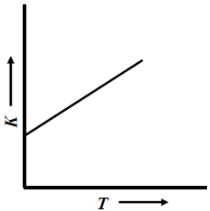Question
Question: Given below are the plots which show the variation of the rate constant (k) with temperature (T). Se...
Given below are the plots which show the variation of the rate constant (k) with temperature (T). Select the plot which follows the Arrhenius equation.
(A) 
(B) 
(C) 
(D) 
Solution
The Arrhenius equation is a formula for the temperature dependence of reaction rates. The units of the pre-exponential factor A are identical to those of the rate constant and will vary depending on the order of the reaction. If the reaction is first order it has the units: s−1 , and for that reason it is often called the frequency factor or attempt frequency of the reaction.
Complete step by step answer:
The Arrhenius equation is k=Ae(−Ea/RT), where A is the frequency or pre-exponential factor and e(−Ea/RT) is the fraction of collisions that have enough energy to react (i.e., have energy greater than or equal to the activation energy Ea) at temperature T.
Rate constant K increases exponentially with the rise in temperature. Since the rate constant K also depends upon orientation factor A. Hence, its maximum value is not infinity, rather it is limited to an optimal value.

Therefore, the correct representation of variation of the rate constant (k) with temperature (T) is shown
So, the correct answer is “Option A”.
Note: Activation energy is the energy that must be provided to compounds to result in a chemical reaction. The activation energy (Ea) of a reaction is measured in joules per mole (J/mol), kilojoules per mole (kJ/mol) or kilocalories per mole (kcal/mol). This equation has a vast and important application in determining the rate of chemical reactions and for calculation of energy of activation.
